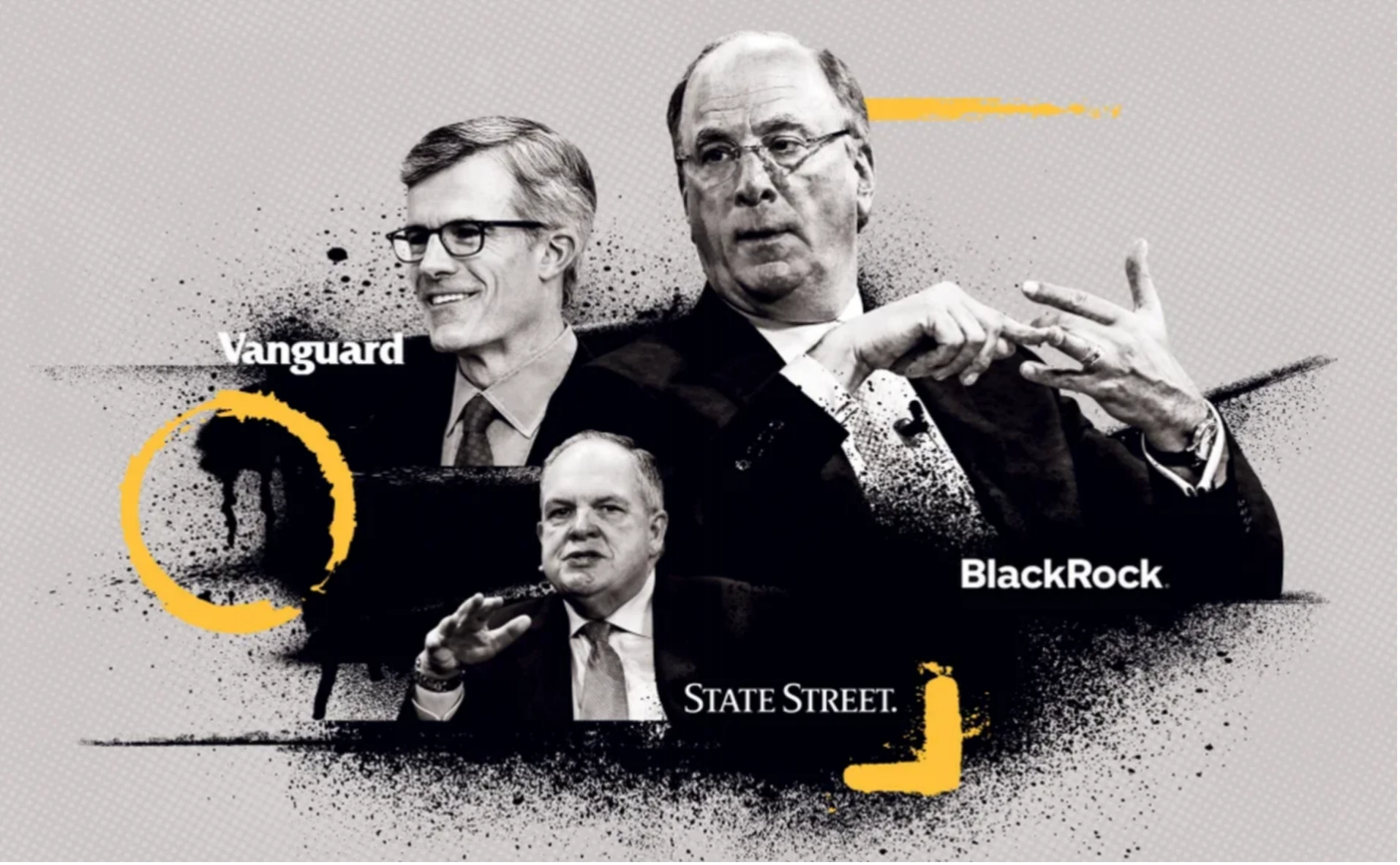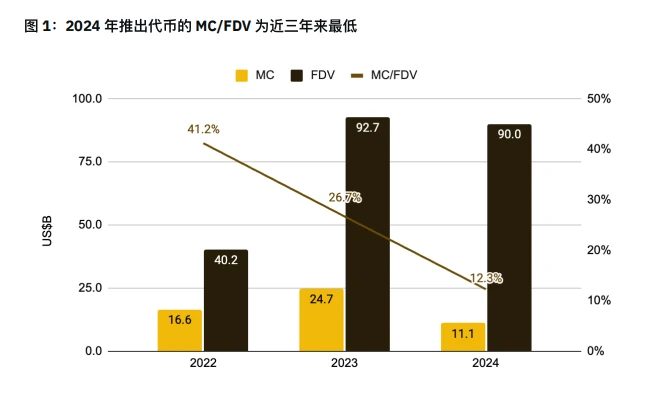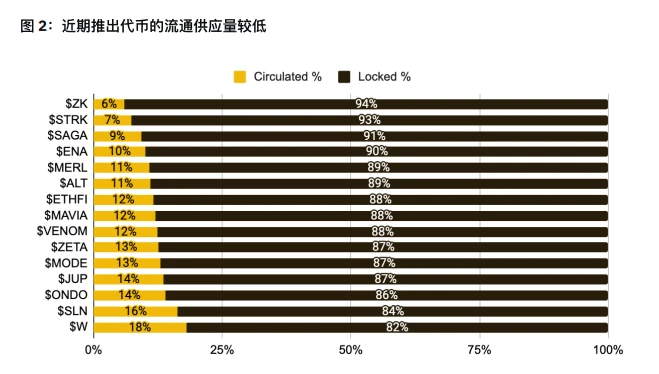Autor original: Investigador de YBB Capital, Ac-Core

Resumen
-
Unlike the previous bull market, which was driven by macroeconomic prosperity, this round of crypto market is mainly affected by macroeconomic uncertainty;
-
ETF is just an ibuprofen sustained-release capsule, and the trend of crypto-US stocks has become a tightening curse on the industrys growth potential;
-
The current bull market is almost limited to Bitcoin. The main reason for the sluggish performance of altcoins is the lack of overall industry innovation, insufficient liquidity, and overvaluation of the primary market. The overall capital driving force is limited, and the market is difficult to increase in volume;
-
With industry innovation stagnating, the entry of traditional institutions such as BlackRock can provide a certain amount of incremental funds, but it cannot change the trend of market involution, and it is difficult to support sustained growth by playing the old tune;
Can the cyclical rise of halving in four years be repeated?
1.1 The starting point of the bull market is completely different
Perhaps out of resistance to the over-issuance of national sovereign currencies and monetary policy intervention, Bitcoin was coincidentally born against the backdrop of a global economic crisis. From the perspective of development history, before Bitcoin was widely banned in China in 2021, China was the main promoter of the crypto industry, and domestic single mining volume once accounted for two-thirds of the global total. At the same time, Chinas overall economy developed rapidly driven by the real estate and Internet booms. The macroeconomic environment before 2021 was favorable, and the central banks monetary easing policy stimulated the markets investment enthusiasm. However, with the cooling of real estate after 2020 and the decline of the overall economy, some market liquidity was gradually withdrawn.
Looking at industry innovation from a rearview mirror perspective, DeFi Summer promoted Ethereums internal circulation economy and became the main driving force for its explosion. Subsequently, NFT, MEME, and GameFi continued to break through the circle, attracting massive traffic resources and triggering a craze for digital collections. The rise in the industrys market value has driven the development of the entire industry. However, this round of innovation is mostly old songs played again and has not brought substantial breakthroughs. Or perhaps the bull market has not really arrived yet, and the new narrative has not yet set off enough waves.
If we consider the period from the beginning of 2019 to the beginning of 2021 as the starting point of the last bull market, Bitcoin was in the price range of 4K-1W USD, and Ethereum was in the range of 130U-330 USD. The entire crypto market was relatively small, and there was huge room for growth. However, according to data from CompaniesMarketCap, Bitcoins market value is currently ranked 10th in the world, second only to Facebook, with about three times the growth space from Apple and about 15 times the growth space compared to gold. However, compared with the last bull market, the overall expected growth space has been greatly reduced.
The rise driven by halving is the core narrative of the last bull market. The cyclical growth of the crypto market is always closely related to the macro economy. Since the creation of the Bitcoin block in 2009, its market value has exceeded 1 trillion US dollars, which is inseparable from the cyclical monetary easing stimulus. However, the only constant in the financial market is change. Even if you have achieved a position, you cannot know how deep you will dive.

Data source: CompaniesMarketCap
1.2 What is the positioning of Bitcoin and where is its future growth potential?
Is Bitcoin鈥檚 safe-haven property just a consensus within the industry?
To this day, the US dollar still controls the global economy through pricing power, while gold, as a safe haven for hedging and preserving value, has seen its historical highs accompanied by major crises. The first carnival began with the collapse of the Bretton Woods system after the end of World War II, when the dollar decoupled from gold, driven by geopolitics and inflation. The second carnival began in 2005, when a large amount of funds poured into the gold safe haven after the subprime mortgage crisis. After the end of the Libyan war in 2011, geopolitics remained a key factor. The third carnival was after 2018, when the COVID-19 pandemic and local geopolitics drove up gold prices. Overall, gold has always been the first choice for hedging risks, and the Feds quantitative easing to expand money supply and geopolitics are the main drivers of its price increases.
According to Beijing time on Thursday (September 12), spot gold closed up 1.84% at $2,558.07/ounce, a record high; spot silver rose 4.19% to $29.8792/ounce. COMEX gold futures rose 1.78% to $2,587.6/ounce, also breaking the historical closing record (data source: Qianzhan.com Research and Selection Express). Bitcoin and golds positioning as safe-haven assets seems to have been broken. Gold has soared, but Bitcoin has failed to keep up. Instead, its price trend is closer to that of US stocks.
Bitcoin鈥檚 greatest value: a tool to resist economic sanctions and lack of trust in fiat currencies
In the context of economic globalization, all countries hope to achieve the international circulation, reserve and settlement of their own legal tender. However, the trilemma between monetary sovereignty, free circulation of capital and fixed exchange rates still exists. From what I have read in Currency Wars, paper money itself has no value. It only relies on the credit endorsement of the state. Those who control the right to issue currency can actually override the law. Even the hegemony of the US dollar is difficult to support such a large-scale credit endorsement for a long time. Behind the global economic globalization, the essence is the unsolvable contradiction between monetary globalization and national interests. Taking El Salvadors adoption of legal currency dualization to promote the use of Bitcoin throughout the country to weaken the hegemony of the US dollar as an example, Russia has allowed residents to trade cryptocurrencies and use them for trade settlement since September 2024 to circumvent sanctions.
The embarrassment of Bitcoin is that its value comes from hedging the risk of trust in legal currency, but its rising momentum depends on the policies of powerful countries, the adoption of monopoly capital and the influence of the macro environment. This dual dependence makes Bitcoin challenge the traditional financial system while still being restricted by its rules.
2. ETFs are only a short-term pain reliever, not a cure-all
2.1 The post-ETF era of crypto: failed power struggle

Image source: The Guardian-News
Bitcoin was born coincidentally against the backdrop of the global economic crisis. The unique properties of blockchain have the potential to resist the over-issuance of national sovereign currencies and monetary policy intervention. Anti-power, freedom, and decentralization were once the beliefs and slogans of the industry. However, most of the players in the industry have a speculative mentality, and getting rich overnight seems to have become the primary productive force driving the development of the industry. Although the launch of the Bitcoin ETF is a positive, it is ultimately just an unavoidable one-time event and cannot support the market in the long run.
Once upon a time, most of us believed in resisting the powerful, but now we place our hopes on the power of the powerful. In our utopia, we seem to care only about profits and not about the direction. The market is full of cheers for the good news of ETFs, and everyone hopes that more funds will flow in to take over our positions. However, we who once struggled to fight against the powerful are now handing over our achievements to the powerful step by step. This change reflects the profound contradiction between ideals and reality.
Giants like BlackRock, Vanguard, and State Street control the world, and now BlackRock is controlling Bitcoin.
The most influential companies in the world are not Apple, Tesla, Google, Amazon or Microsoft, but the worlds largest asset management companies. BlackRock is one of them. From 2009 to 2023, it has been the worlds largest asset management company for 14 consecutive years, managing trillions of dollars in assets. Compared with technology giants, these asset management companies have a more far-reaching economic influence through the global flow of capital.
The direct impact of the post-ETF era is that the price of crypto assets will be closer to the trend of traditional finance. Only by holding more chips can you have a greater voice in the industry. Today, the United States is gradually controlling the development of the crypto industry through ideology. According to QCP Capital on September 10, macroeconomic uncertainty has become the dominant factor in the crypto market, and the 30-day correlation between BTC and the MSCI World Stock Index has reached 0.6, close to a two-year high. This shows that the price trend of Bitcoin is increasingly affected by the performance of global stock markets.
The crypto industry did germinate in China at first, but now the big players have changed and more professional competitors are emerging. In the future, in addition to screening brand IP and track sectors, it is also necessary to have strong trading and transaction capabilities. The Matthew effect will penetrate into every corner of the industry, and the crypto world is gradually ushering in Wall Street-level trading difficulties.
2.2 The Gold Rush Metaphor
Looking back at the California Gold Rush more than a hundred years ago, hundreds of thousands of gold diggers from all over the world flocked to California with the dream of getting rich overnight. However, most of them returned empty-handed, and some even lost their lives. In contrast, Levi Strauss took a different approach and used the large amount of canvas he had stockpiled during the Gold Rush to make pants and sell them to gold miners. Because of their practicality, they were very popular. Later, he improved the pants and became the founder of jeans, and founded the now world-famous Levis company.
Interestingly, Bitcoin mining in PoW and Ethereum staking in PoS are similar to this to some extent. The mining craze of PoW makes gold diggers carry mining machines, while the staking craze of PoS makes them use their own capital. However, characters like Levi are everywhere – behind this game, you are looking at the dream of getting rich overnight, while I am looking at the capital you have. The 7*24-hour global and uninterrupted transactions of blockchain have brought countless opportunities to gold diggers, but it has also made the market particularly prone to ups and downs. High risks are accompanied by high returns, and profits and risks continue to affect everyones courage and diligence.
Behind the fast-paced, non-stop trading and highly volatile market are both tempting traps and unlimited trading opportunities. This is the greatest charm of Crypto. The dual blessing of strong financial attributes and low entry barriers makes Crypto a natural and high-quality gold mine. We once shouted that the benefits of ETFs will bring more off-market funds, but the approval of ETFs also opened the door to more Levi-Strauss, creating more opportunities for arbitrage and indirect income.
The crypto market will involve more Levis
ETFs not only bring exposure funds, but also provide risk hedging transactions. The biggest innovation of blockchain is to put finance on the chain, create a self-cultivating economic cycle in the crypto market, and successfully block the direct intervention of power and traditional capital. However, in the post-ETF era of crypto, the crypto market will, to some extent, give up a full range of financial derivatives, which will only attract more arbitrageurs and large funds to enter the market, further compressing the already limited market profit space and weakening the innovation driving force and freedom in the market.
3. The primary market is difficult to break
Primary market with low circulation and high FDV
Recently, the financing situation in the primary market has changed significantly compared with the past. The listed tokens generally show extremely high FDV (fully diluted valuation) and low liquidity. According to the data provided by Binance in Observations and Thoughts on the Current Situation of High Valuation and Low Circulation Simbólicos, the ratio of market value (MC) to FDV of tokens launched in 2024 is the lowest in recent years. This shows that a large number of tokens will still be unlocked in the future, and the FDV of tokens issued in the first few months of 2024 is close to the total in 2023.

Image source: @thedefivillain, CoinMarketCap and Binance Research, data released on April 14, 2024
In a market that is generally illiquid, tokens are gradually unlocked after TGE (token generation event), which brings a lot of selling pressure to the market. However, did VCs really make money in this round of the market? Not necessarily. Usually, for compliant and regulated project financing, token unlocking requires at least a one-year cliff period. However, when a project has high FDV and low liquidity, it is very easy to encounter a break after unlocking. But this does not rule out the possibility that some small VCs will profit through dumping in the secondary market or selling off-market in advance. As shown in the data in the figure below, the circulating supply ratio of these tokens is generally less than 20%, and the lowest is only 6%, and the high FDV phenomenon is very significant.

Image source: CoinMarketCap and Binance Research, data released on May 14, 2024
The current capital-driven benefits have obviously become ineffective temporarily. In addition to the aforementioned reasons, there are some objective factors that have led to the current low circulation and high FDV market situation:
1. The market is fragmented, with more wolves and less meat : In the last round of bull market, global capital was working together to hype DeFi and public chains, but in this round of the market, funds and participants are too dispersed, narratives are diversified, and Eastern and Western capital do not take over each other. It often happens that there are not enough takers for the coins issued, and the market is fragmented;
2. Lack of altcoin bull market, insufficient hype : The infrastructure of the EVM-based public chain has been perfected, funds and projects are rolling in the same direction, and Ethereum killers have not brought new breakthroughs. In the absence of altcoin bull market, after the benchmark project came out, similar projects quickly emerged, which in turn exacerbated the value depression effect;
3. Simple things are complicated, and complicated things are story-telling : Pseudo-innovation can be found everywhere in the market. Simple things are artificially complicated just to tell the market about bigger dreams, but in essence, the substance remains the same in a new bottle.
4. The Matthew effect is becoming more and more obvious : the crypto industry has been developing for nearly 16 years, and the monopoly effect of the head has basically been generated. Whether it is technology, projects, or investors that have survived to this day, the strong ones have become stronger and the weak ones have become weaker, and the market voice of the head companies has become more and more stable;
5. Lack of innovation and liquidity : The primary challenges facing the current market are the lack of innovation and insufficient liquidity, which make it difficult for the market to rise in volume and the overall development is stuck in a bottleneck.
This article is sourced from the internet: Rigidity, Bubble, Crisis, Ice-breaking
Related: OpenSea received a notice from SEC Wells, is the NFT track scheduled to fail in advance?
Original|Odaily Planet Daily ( @OdailyChina ) Author: Wenser ( @wenser2010 ) Just yesterday, OpenSea, once the largest NFT trading platform, received a Wells Notice from the US SEC, becoming another targeted crypto project after Coinbase, Lido, Bittrex, Uniswap, and Robinhood . (Note from Odaily Planet Daily: The Wells Notice is an informal reminder issued by the US SEC before filing a civil lawsuit against a US-listed company. Companies that receive the notice can communicate and negotiate with the SEC before receiving a formal lawsuit.) In response, OpenSea said it plans to provide $5 million to pay legal fees for NFT artists and developers who received the Wells Notice, and that it is ready to fight for the industry; Uniswap founder Hayden Adams was also speechless about this, and posted a…







